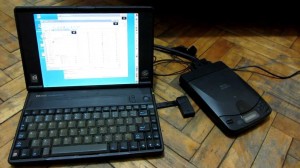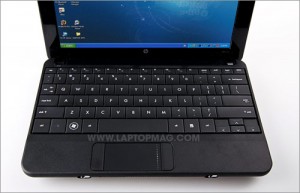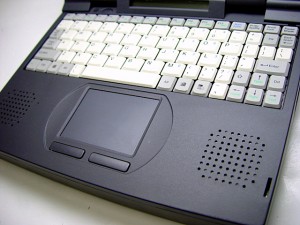
HP Omnibook 600CT: funky and clunky; HP Omnibook 800CT: more powerful, but blows up my power adapter
More tales of a vintage laptop collector/hobbyist and a lifelong devotee of WordPerfect for DOS…
Everyone knows the story of Goldilocks and the three bears. A writer prefers his laptop much like Goldilocks prefers her chair, her porridge, and her bed: Just Right. Anything short of Just Right just won’t do.
Until the death of my Amity CN from CMOS battery failure, I had enjoyed a Just Right laptop for the past four years. It wasn’t too big for writing on the train or too heavy for carrying the several city blocks to and from my office; but it wasn’t so small and so light that it slid around on my lap when the train came to a stop or hit a rough patch of tracks. Its screen was large enough to allow me to read what I typed without strain, but not so large that it banged into the seatback ahead of me. It wasn’t too antiquated and slow to run WordPerfect 5.1 adequately, but it wasn’t so new that it wouldn’t properly run DOS programs, either. Its keys had a pleasing clicky firmness, but they weren’t too firm. Its power management features worked great. I had plenty of batteries for it with lots of life left in them.
But my Just Right laptop had ended up Just Dead.
So, on to the next one! If Lon Chaney, Sr. was the Man of A Thousand Faces, I, at one time, was the Man of A Thousand Laptops (well, two hundred and fifty laptops and palmtops, but close enough). Even though I had divested myself of about a hundred and sixty vintage machines from my collection prior to my move to Virginia, I still retained a fairly awesome armada of old silicon and plastic.
There was just one problem. I had been writing on a computer since 1988. I had twenty-five years’ worth of files. Even given that virtually all of those files were compact WordPerfect 5.1 or 4.2 files, they still took up a good bit of hard drive space, especially given the storage constraints of pre-Windows 95 laptops. Most of my machines had hard drives of only 40, 60, or 80 megabytes. My oldest DOS machines’ hard drives were even tinier – 20 megabytes – and prior to my divestment, I had owned a bunch of laptops that had no hard drives at all (my very first laptop, a Tandy 1100FD, had run all its programs off a single 720Kb floppy drive).
I had reached the point where my stuff simply wouldn’t fit on the oldest of my old machines anymore, even if I limited my programs to just DOS and WordPerfect, nothing else. And then there was the ever-present conundrum of batteries. My really old machines required really expensive replacement batteries, or no batteries could be found for them at all.
One machine that I had plentiful spare batteries for was my emergency backup laptop, which I’d been using since my Amity had died – a Hewlett-Packard Omnibook 600CT. Powered by a 75 MHz 486 processor, it had more than adequate horsepower to run DOS programs. It weighed just a bit over three pounds and was sturdily constructed (although this particular unit was missing several slot covers; just cosmetic issues, though, nothing that detracted from its functionality). I had written on it several times before. But its installation of Windows 3.1 (remember that one?) had gotten corrupted, and this had somehow caused a loss of access to the unit’s Setup program. Which meant I couldn’t get its power management features to work, which meant I couldn’t have the Instant On/Take Up Where I Left Off feature that I’d gotten so used to with both my Poqet PC and my Amity CN and had found so handy.
Well, I seemed to have a solution in hand. One of my other machines in storage was the follow-up to the Omnibook 600CT, an HP Omnibook 800CT, the upgraded model with a 133 MHz Pentium processor and Windows 95. All of the batteries I’d acquired for the 600CT also fit the 800CT, since their chasses were identical (both units featured the famous-but-weird Omnibook pop-out mouse, an odd little mechanical protrusion which springs forth from the laptop’s side like Athena from Zeus’s head). Not only did the batteries fit, but I also had an external CD-ROM drive for the 800CT, a proprietary drive unique to that model which would make my transferring my files onto the newer machine a much quicker process than relying upon Laplink cables and serial port transfers.
The $100 question… would the 800CT, which I hadn’t tried booting up since my days in New Orleans more than four years ago, still work?
I plugged in the 800CT with the power adapter I’d been using for the 600CT. At first, it appeared to be a no-go. But when I stuck the tip of a pen into its tiny reset slot, it booted up. Wonderful! I appeared to be in business. Well satisfied, I left the room to go tuck my boys into bed.
When I returned three minutes later, the 800CT had gone dark. Not even pressing the reset button could get it to boot again.
Crestfallen, I figured I’d have to try another machine. In the meantime, I’d stick with the 600CT. It was almost out of hard drive space, and its almost full-sized keys were on the stiff side, but at least it worked. I plugged it in with the same charger I’d just used with the 800CT. The 600CT did not charge. The power adapter had died.
I went down to the basement to where I had a complete Omnibook 300 in a box, the original model in the Omnibook series. It had a power adapter that fit the 600CT. In fact, I vaguely remembered that I’d borrowed an Omnibook 300’s A/C adapter for the 600CT when the 600CT’s original adapter had given up the ghost; it had been this adapter which had just stopped working.
The newly borrowed adapter from the 300 worked just fine in the 600CT. I wondered whether it had been a coincidence that my other adapter had died when it had. Had it truly been coincidental, or had plugging the unit into the 800CT fried the adapter?
I did some online research. The recommended adapter for the both the 600CT and the 800CT was the same unit. The A/C adapter for the Omnibook 300 (a much lower powered, 25 MHz 386-class machine) had a plug which fit the 600CT and the 800CT, and its wattage was identical to the wattage of the adapter for the new machines, but its amperage was lower. So, chances were, whereas the 300’s adapter was just adequate to power the 600CT’s 75 MHz 486 processor, it was sadly overmatched by the power requirements of a 133 MHz Pentium processor. In all likelihood, I’d fried the old adapter.
I ordered a new one on eBay, still not 100% certain the 800CT would work. And in the meantime, I still needed a replacement laptop.
One potential candidate sat unused in my son Levi’s bedroom. This was a much more up-to-date small laptop than I’d ever used for my writing before, an HP Mini 110, a 2.6 pound netbook which Dara and I had acquired as a freebee back in 2009 when we’d signed up with our present cell phone provider. It was the right size for the train, and it had a strong battery; I’d spent an extra $20 or so to buy the upgraded six-cell battery when we’d gotten it. None of my boys bothered with it because it ran their Internet games and programs so slowly. With a 1.6 GHz Intel Atom processor and running Windows XP, it wasn’t a speed demon when it came to online activity, but I figured it would run WordPerfect 5.1 like a Saturn V rocket… if it ran it at all. Any Windows after Windows 2000 ran the old DOS programs in a somewhat funky fashion.
I managed to load WordPerfect 5.1 using a USB external floppy drive. A few minutes’ worth of playing with the netbook’s video settings allowed me to see a somewhat normal, non-squashed version of WordPerfect’s classic white-Courier-font-on-blue-background. I tried out the keyboard to see how it felt. It felt wonderful, one of the most delightful keyboards I’d ever experienced on a sub-3 pound laptop.
But where were the Home, End, Pg-Up, and Pg-Dn keys?
I couldn’t find them. DOS WordPerfect was unthinkable without them. I put on my reading glasses. The twelve function keys at the top of the keyboard had mostly been given over to Mini-specific functions, but they were still marked, in a lighter and much smaller font, with the traditional F1 through F12. Were any of the other keys sub-marked with Home, End, Pg-Up, or Pg-Down, accessible through simultaneous pressing of an FN key?
Nope. The Mini had simply done away with those keys.
I went online to see if the Mini’s keyboard could be user reprogrammed. The closest I could find to this functionality was a virtual keyboard which could be called up with a utility program available on the Hewlett-Packard support site. But whereas this could be useful for native Windows NT programs, it didn’t help at all with DOS programs that required the missing keys.
Back to the old drawing board it was.
A quick look around the racks of laptops down in the basement reminded me that I had bought a then brand-new (new old stock, to be precise) Soyo PW9800 Mini subnotebook back in 2001. The laptop, manufactured in 1998, weighed 3.5 pounds, had an 8.1” screen, had Windows 98 installed, and was powered by a 180 MHz Cyrix MediaGX processor. Complete in the original box, it came with both an external floppy drive and an external CD-ROM drive (the latter of which promised relatively easy file transfers). I hadn’t opened the box more than two or three times since I’d received it, mostly just to have a look at the thing and test it.
The Soyo, on paper, at least, fit my needs to a T. It might be impossible to find a replacement battery for such an obscure model (which was also sold under the NEC brand; Soyo was primarily a maker of motherboards, not complete laptops), but the original battery had never been used, so I figured it should have some useful life left. Cracking open the Soyo’s box, I felt like I’d just treated myself to a brand-new vintage machine, never abused by previous owners (the collector’s ultimate dream, of course). How exciting!
No… how disappointing.
The Soyo might have been mint, “untouched by human hands” (to quote the title of a famous short story by SF dean Robert Sheckley). But it also sucked lemons. Just a few minutes of use demonstrated that it was, hands down, the absolute worst laptop, of any size, vintage, or make, I have ever tested.
First of all, it is incredibly, dismayingly flimsy. The first thing I did upon unloading all of the box’s contents was to remove the rechargeable battery from its storage bag and install it into the machine, so I could gauge its state of health. The battery bay’s cover, I saw, was removed by pressing down on a tab and sliding it open. I did so. I instantly heard a SNAP! The battery bay door then fell off, trailing a tiny broken piece of plastic, which was, as it turned out, the latch.
I picked up the piece of broken plastic from the carpet. It was thinner than the plastic to be found on a fifty cent toy from a bubblegum dispenser.
As one might well imagine, this experience, my first upon handling the Soyo, did not inspire much confidence within my breast regarding my new/old laptop.
Without the latch, the battery hatch door would not stay on. I was forced to resort to a wide strip of packing tape. All you collectors out there know that a kludge like this is the kiss of death to any notion of mintness. My machine wasn’t “new old stock” anymore. It was… gasp… broken. It was as though I had gone to bed with Rita Haywood and had woken up next to Margaret Hamilton… who was still wearing her green Wicked Witch of the West makeup.
Worse was yet to come, though. I resigned myself to using a taped-together laptop; at least the piece of packing tape was on the bottom of the machine, where I wouldn’t have to look at it. So, while letting the battery charge, I decided to test the keyboard.
WORST. KEYBOARD. EVER. DESIGNED.
Take a look at that photo of the Soyo’s keyboard. Notice the right Shift key? No? You can’t find the right Shift key? Maybe, perhaps, because it is so damned SMALL???
This one flaw made it impossible for me to touch type on this machine. That devilishly small right Shift key, sized no bigger than a standard letter key, sat right next to a whole plethora of potential trouble makers – namely, the Arrow Up key, the Delete key, and the Arrow Down key. So every time, and I mean every time I had to use the right Shift key to capitalize a letter, I was either moving my cursor up a line, down a line, or deleting something. Every damned time.
I experienced a visceral hatred of the Soyo. I dreaded the very thought of ever having to type on it. If it were the last laptop on Earth, I would not use it. Never, ever, ever. I would rather scratch my prose onto sheets of dried papyrus. I would rather punch myself in the nose and scrawl out my words in my own blood.
Having struck out with three seemingly promising candidates in a row, I was back to Square One. A man without a country. A writer without his laptop.
(Our saga continues on Sunday!)






